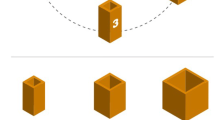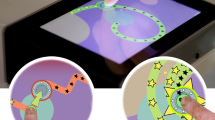Abstract
Prospective control when catching moving toys was studied longitudinally in full-term and preterm infants between the ages of 22 and 48 weeks. The toy’s distance and time to the catching place and its velocity were explored as possible timing strategies used by infants to start their hand movement. The aim of the study was to find evidence for a shift in timing strategy and whether there were differences between full-term and preterm infants. In addition, it was investigated how infants continuously guided their hands to the toy and whether this guidance was influenced by their use of timing strategy. The toy approached the infants from the side with different constant velocities and constant accelerations. Results showed that there was little difference between full-term and preterm infants’ use of timing strategies. Initially, infants used a distance- or velocity-strategy, possibly causing them to have many unsuccessful catches. After a shift to a time-strategy, infants appeared to increase the number of successful catches and performed longer and more functional tau-couplings between the hand and the toy. One preterm infant did not switch to a time-strategy, and frequently missed the moving toy. The same infant also showed less functional tau-coupling with non-controlled collisions between the hand and the toy. More follow-up research is needed to investigate whether problems with extracting the relevant perceptual information for action could be an early indication of later perceptuo-motor difficulties.








Similar content being viewed by others
References
Aanondsen CM, Van der Meer ALH, Brubakk A-M, Evensen KAI, Skranes JS, Myhr GE, Van der Weel FR (2007) Differentiating prospective control information for catching in at-risk and control adolescents. Dev Med Child Neurol 49:112–116
Adolph KE, Berger SA (2006) Motor development. In: Kuhn D, Siegler RS (eds) Handbook of child psychology: vol 2: cognition, perception, and language. Wiley, New York, pp 161–213
Benguigui N, Ripoll H, Broderick MP (2003) Time-to-contact estimation of accelerated stimuli is based on first-order information. J Exp Psychol Hum Percept Perform 29:1083–1101
Bertenthal B, Von Hofsten C (1998) Eye, head and trunk control: the foundation for manual development. Neurosci Biobehav Rev 22:515–520
Bootsma RJ, Van Wieringen PCW (1990) Timing an attacking forehand drive in table tennis. J Exp Psychol Hum Percept Perform 16:21–29
Caljouw SR, Van der Kamp J, Savelsbergh GJP (2004) Catching optical information for the regulation of timing. Exp Brain Res 155:427–438
Campos JJ, Anderson DI, Barbu-Roth MA, Hubbard EM, Hertenstein MJ, Witherington D (2000) Travel broadens the mind. Infancy 1:149–219
Fajen BR (2005) Perceiving possibilities for action: on the necessity of calibration and perceptual learning for the visual guidance of action. Perception 34:717–740
Gibson EJ (1988) Exploratory behavior in the development of perceiving, acting, and the acquiring of knowledge. Annu Rev Psychol 39:1–41
Gibson EJ, Pick AD (2000) An ecological approach to perceptual learning and development. Oxford University Press, New York
Glass GV, Hopkins KD (1996) Statistical methods in education and psychology. Allyn and Bacon, Boston
Jacobs DM, Michaels CF (2006) Lateral interception I: operative optical variables, attunement, and calibration. J Exp Psychol Hum Percept Perform 32:443–458
Jacobs DM, Runeson S, Michaels CF (2001) Learning to visually perceive relative mass of colliding balls in locally and globally constrained task ecologies. J Exp Psychol Hum Percept Perform 27:1019–1038
Jongmans M, Mercuri E, de Vries L, Dubowitz L, Henderson SE (1997) Minor neurological signs and perceptual-motor difficulties in prematurely born children. Arch Dis Child 76:F9–F14
Kayed NS, Farstad H, Van der Meer ALH (2008) Preterm infants timing strategies to optical collisions. Early Hum Dev 84:381–388
Kayed NS, Van der Meer ALH (2000) Timing strategies used in defensive blinking to optical collisions in 5- to 7-month-old infants. Inf Behav Dev 23:253–270
Kayed NS, Van der Meer ALH (2007) Infants’ timing strategies to optical collisions: a longitudinal study. Inf Behav Dev 30:50–59
Larroque B, Ancel P-Y, Marret S, Marchand L, André M, Arnaud C, Pierrat V, Rozé J-C, Messer J, Thiriez J, Burguet A, Picaud J-C, Bréart G, Kaminski M (2008) Neurodevelopmental disabilities and special care of 5-year-old children born before 33 weeks of gestation (the EPIPAGE study): a longitudinal cohort study. Lancet 371:813–820
Lee D, Davies MN, Green PR, Van der Weel FR (1993) Visual control of velocity of approach by pigeons when landing. J Exp Biol 180:85–104
Lee DN (1998) Guiding movement by coupling taus. Ecol Psychol 10:221–250
Lee DN (2005) Tau in action in development. In: Reiser JJ (ed) Action as an organizer of learning and development. Lawrence Erlbaum Associates, Mahwah, pp 3–47
Lee DN, Georgopoulos AP, Clark MJO, Craig C, Port NL (2001) Guiding contact by coupling the taus of gaps. Exp Brain Res 139:151–159
Lee DN, Young DS (1985) Visual timing of interceptive action. In: Ingle DJ, Jeannerod M, Lee DN (eds) Brain mechanism and spatial vision. Martinus Nijhoff Publishers, Dordrecht, pp 1–30
Michaels CF, De Vries MM (1998) Higher order and lower order variables in the visual perception of relative pulling force. J Exp Psychol Hum Percept Perform 24:526–546
Michaels CF, Zeinstra EB, Oudejans RRD (2001) Information and action in punching a falling ball. Q J Exp Psychol 54:69–93
Robin DJ, Berthier NE, Clifton RK (1996) Infants’ predictive reaching for moving objects in the dark. Dev Psychol 32:824–835
Shea SL, Aslin RN (1990) Oculomotor responses to step-ramp targets by young human infants. Vision Res 30:1077–1092
Smith MRH, Flach JM, Dittman SM, Stanard T (2001) Monocular optical constraints on collision control. J Exp Psychol Hum Percep Perform 27:395–410
Tresilian JR (2005) Hitting a moving target: perception and action in the timing of rapid interceptions. Percept Psychophys 67:129–149
Van der Meer ALH, Van der Weel FR, Lee D (1994) Prospective control in catching by infants. Perception 23:287–302
Van der Meer ALH, Van der Weel FR, Lee DN, Laing IA, Lin J-P (1995) Development of prospective control of catching moving objects in preterm at-risk infants. Dev Med Child Neurol 37:145–158
Van Hof P, Van der Kamp J, Savelsbergh GJP (2008) The relation between infants’ perception of catchabelness and the control of catching. Dev Psychol 44:182–194
Von Hofsten C (1979) Development of visually directed reaching: the approach phase. J Hum Mov Stud 5:160–168
Von Hofsten C (1980) Predictive reaching for moving objects by human infants. J Exp Child Psychol 30:369–382
Von Hofsten C (1983) Catching skills in infancy. J Exp Psychol Hum Percept Perform 9:75–85
Von Hofsten C (1991) Structuring of early reaching movements: a longitudinal study. J Motor Behav 23:280–292
Von Hofsten C (2004) An action perspective on motor development. Trends Cogn Sci 8:266–272
Von Hofsten C (2007) Action in development. Dev Sci 10:55–60
Von Hofsten C, Rosander K (1996) The development of gaze control and predictive tracking in young infants. Vision Res 36:81–96
Von Hofsten C, Rosander K (1997) Development of smooth pursuit tracking on young infants. Vision Res 37:1799–1810
Von Hofsten C, Vishton P, Spelke ES, Feng Q, Rosander K (1998) Predictive action in infancy: tracking and reaching for moving objects. Cognition 67:255–285
Acknowledgments
We would like to thank the infants and their parents for their participation, Dr. Farstad and Dr. Johansen for their help recruiting infants, Chris M. Aanondsen and Gry Therese Storsveen for assistance with the testing, and Rune Dahl and Eirik Paulsen for their assistance in the data analysis. We also thank Gert-Jan Pepping for providing us with the tau analysis software and David Lee for many fruitful discussions on tau theory. This research has been financed by EXTRA funds from the Norwegian Foundation for Health and Rehabilitation via the Norwegian Health Association.
Author information
Authors and Affiliations
Corresponding author
Rights and permissions
About this article
Cite this article
Kayed, N.S., Van der Meer, A.L.H. A longitudinal study of prospective control in catching by full-term and preterm infants. Exp Brain Res 194, 245–258 (2009). https://doi.org/10.1007/s00221-008-1692-2
Received:
Accepted:
Published:
Issue Date:
DOI: https://doi.org/10.1007/s00221-008-1692-2




